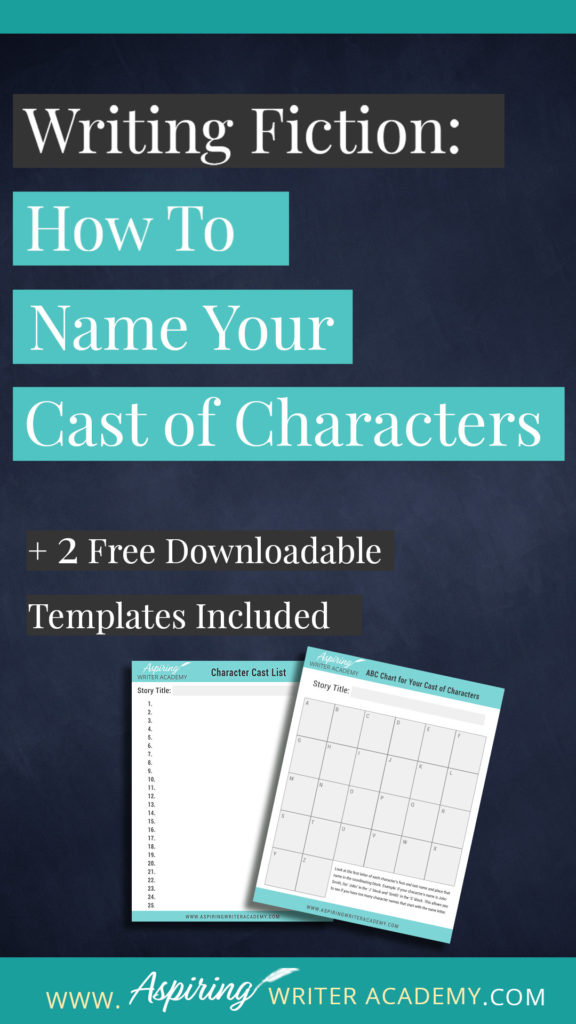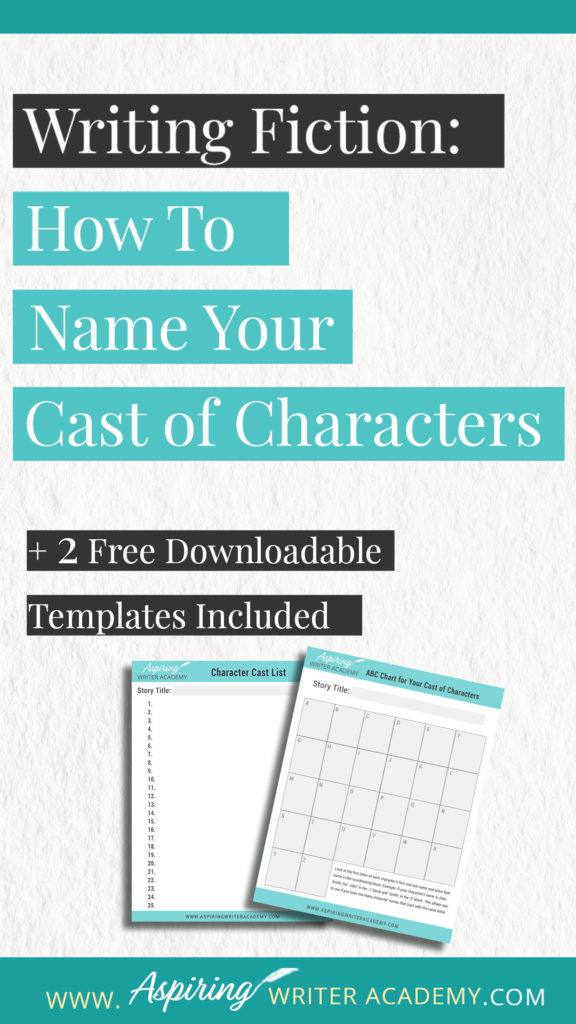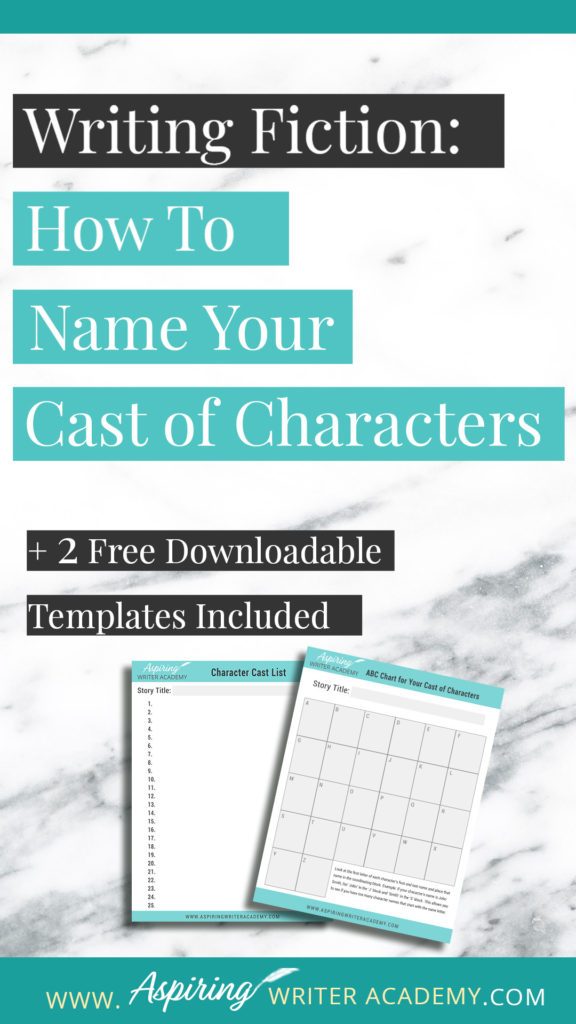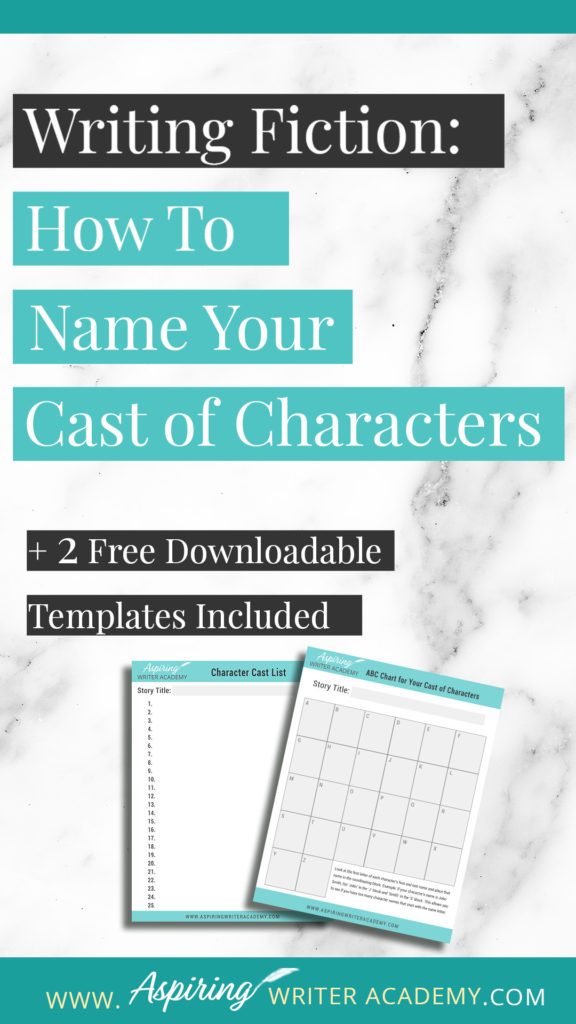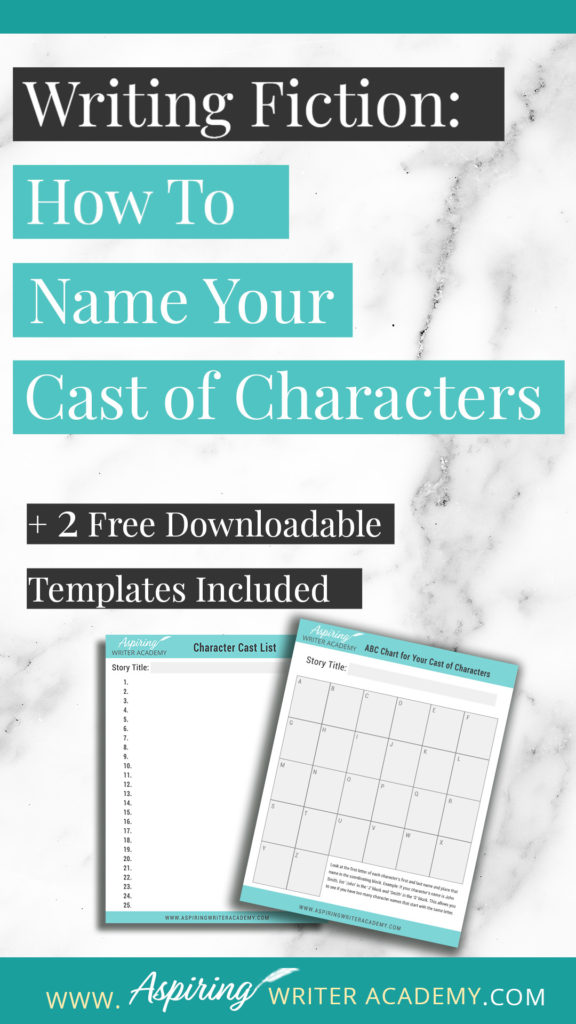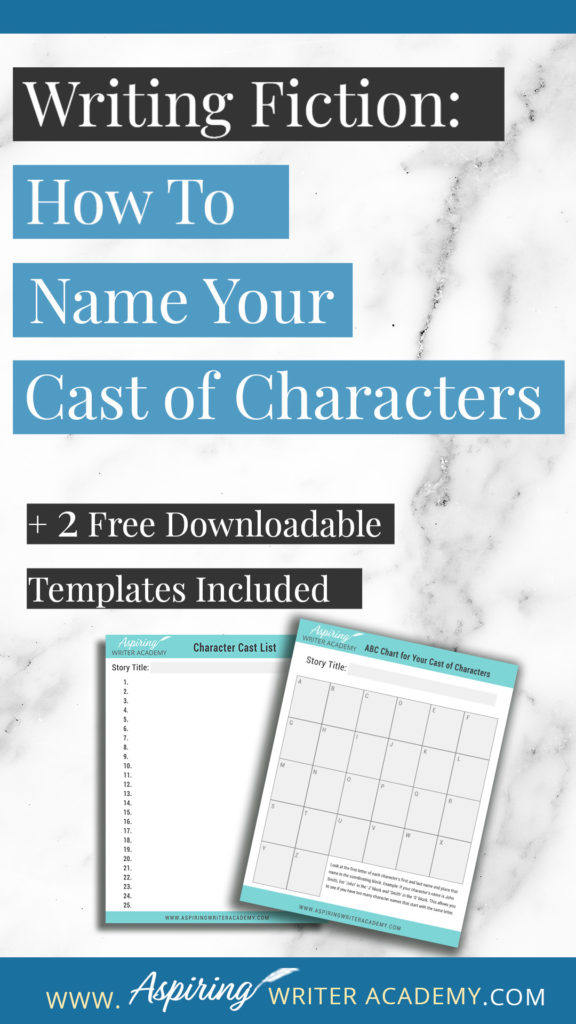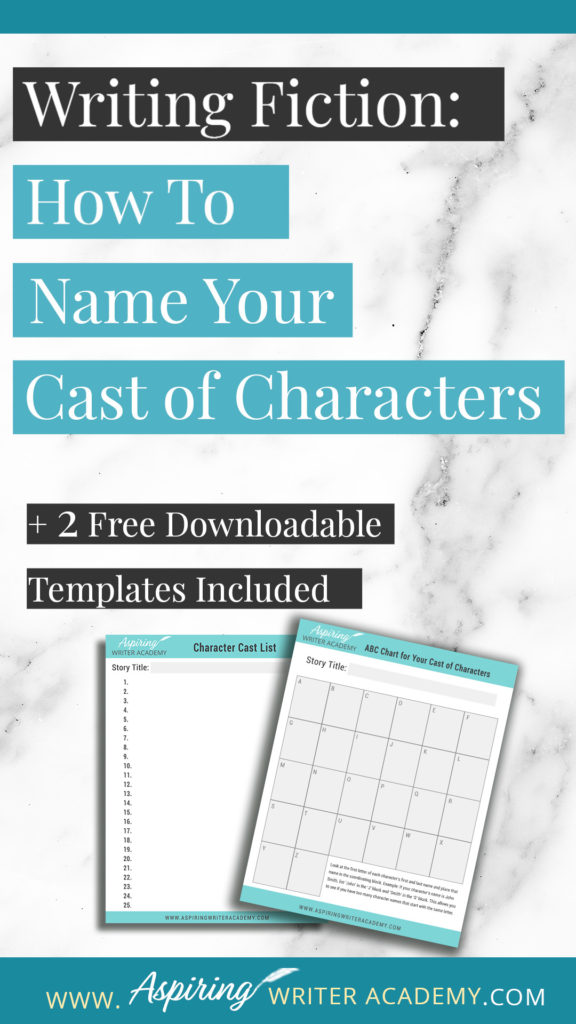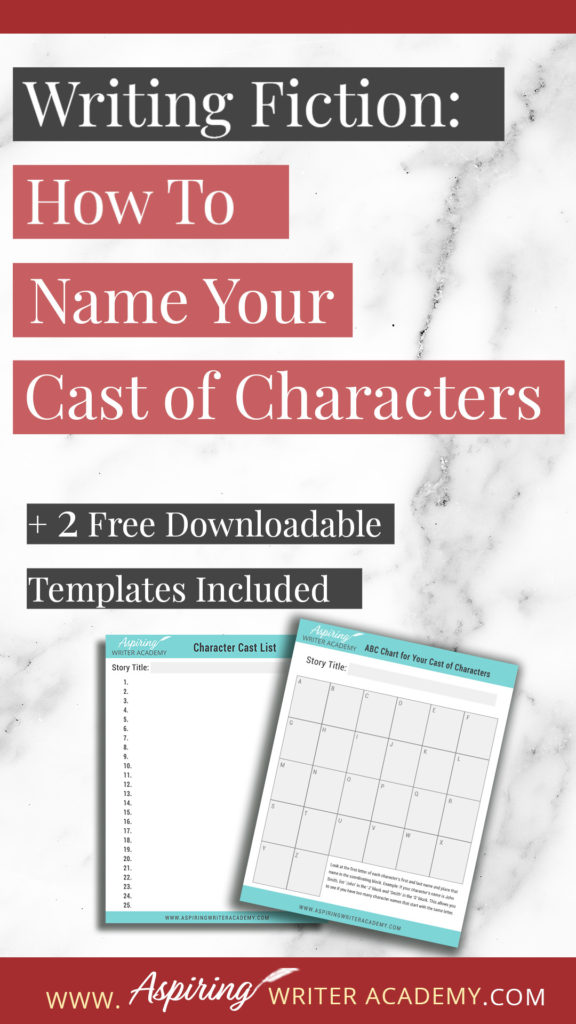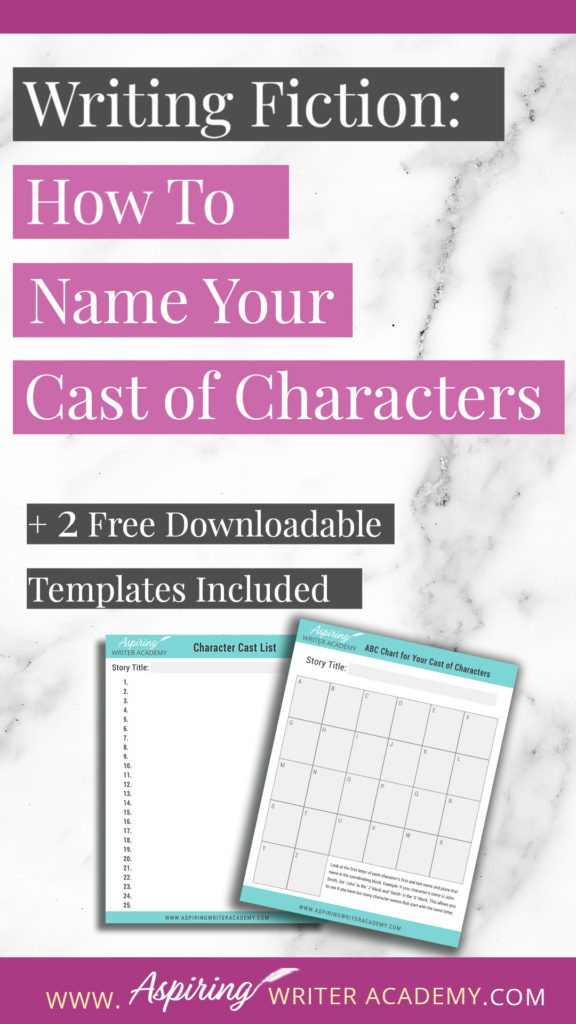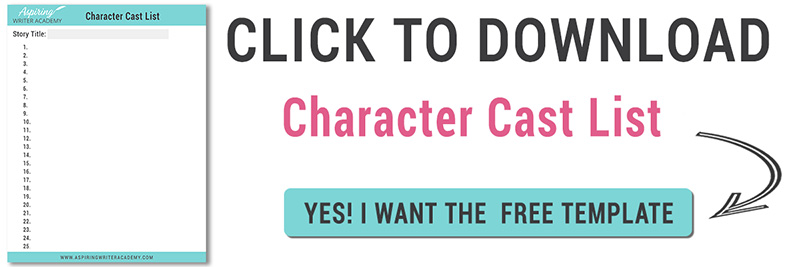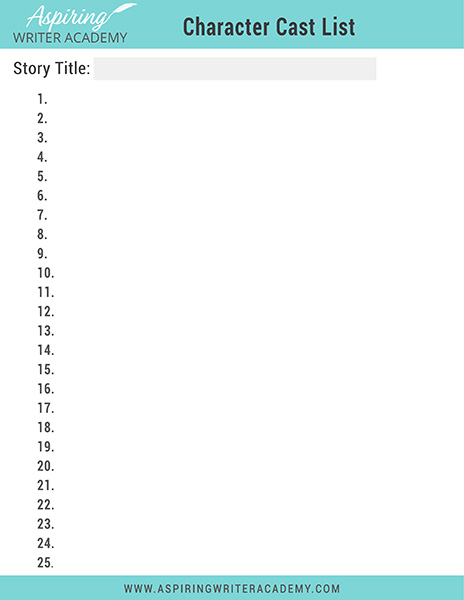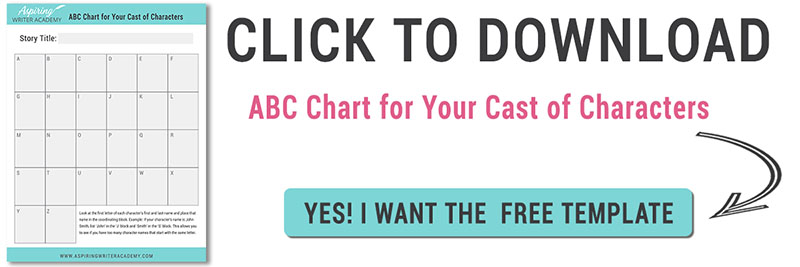Fiction Writing: How to Name Your Cast of Characters

Choosing names for the characters in your fictional story can be done at random, like drawing names out of a hat, or purposely planned out to add greater depth and meaning to the tale you desire to tell.
Whichever method you choose, you may want to consider using our top 5 suggestions for Fiction Writing: How to Name Your Cast of Characters to make each name recognizable, distinguished, and easy to remember for both you and your readers.
We also provide two character-name templates you can use to help you stay organized during the writing process, which can save valuable time and unwanted frustration.
1) Be careful when you use the name of a real person.
Perhaps you want to name your heroine after your favorite aunt or beloved grandfather. Or maybe you wish to include the name of a real historical figure or include the name of a famous movie star or sports celebrity. This is fine. However, you also run the risk of offending this person or their relatives and could end up with a lawsuit. If you do write about a real person, make sure you write about them in a positive way.
Could you use the first name of your aunt and give her a made-up surname? And instead of using all her personality traits, which may make her too identifiable, could you mix a few of her traits in with some other traits that she does not have? What habits or quirks could you give this character so that she appears different than the real person she is named after?
You should also avoid giving your fictional character a name that already belongs to someone in real life who is already well-known for having that name or you run the risk of having your reader unconsciously associate one with the other.
Example: If the character in your story is a sweet doctor but he has the same name as a famous doctor who was caught for being an axe murderer, your reader might not like your character because that negative image of the axe murderer is already planted in the reader’s mind.

Unless you wish the reader to make that name connection.
Example: A boy’s parents in your story name their son after a past president or celebrity because the boy’s parents admire that past president or celebrity and hope their child will grow up to be just as admirable.
Always Google the names you plan to use to make sure there will not be a potential risk of a lawsuit or conflict with a real person with the same name.
However, that is also why in the front of a book below the Copyright many authors include statements such as:
“This novel is a work of fiction. Though some settings and events may be historically accurate, the names, characters, incidents, and dialogue are either products of the author’s imagination or used fictitiously. Any resemblance to actual people is entirely coincidental.”
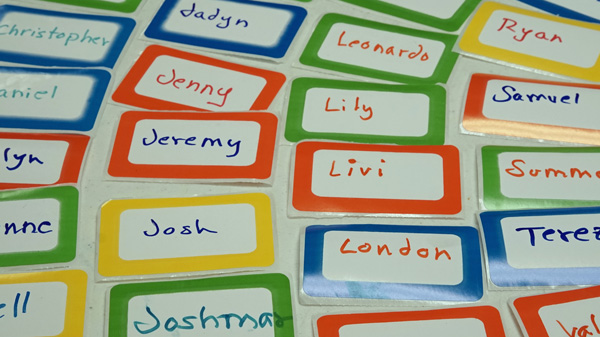
2) You may want to choose a name because it sounds like it belongs to a character with a particular personality.
A name like ‘Daisy,’ ‘Violet,’ or ‘Petunia’ suggests a soft, dainty, quiet, gentle woman like the flower they are named after.
Names like ‘Three-fingered Jack’ might conjure up the image of a pirate or a tough guy with a notorious reputation.
‘Charles Harrington Wallace Stanford III’ might suggest prominence or wealth.
Although, it is always interesting when a character’s appearance or personality is the exact opposite of what their name suggests. Sometimes this also provides humor like the character of ‘Little John’ in the story of Robin Hood, where the man was quite large.

3) Perhaps you may decide a character’s name should hold a special meaning.
(Hint: search Google for ‘meanings of names.’)
- David means ‘beloved’
- Charlotte means ‘free’
- Laura is derived from the word ‘laurel,’ which is a plant used to make a crown of leaves that the Greeks used to put on the head of the winner of a competition. Ancient Romans used these laurel wreaths to decorate the heads of those who came back after winning a war. That is why the name also associated with ‘victory’ or ‘honor’ and ‘good luck.’
If choosing a name for its meaning, you may want to tie it in with the theme for your story or for the character and what he needs to achieve or for the person he needs to become.

4) Choose Names that are different from one another so the reader can easily tell them apart.
1) Try not to have 2 or more character names all start with the same letter like ‘David, Don, Daniel.’ All the ‘D’s get too confusing for the reader.
2) Also, watch that the names do not sound alike like ‘Hannah’ and ‘Savanna’ or ‘Bill’ and ‘Jill’ or ‘Fred’ and ‘Ted.’
3) Look at the ending sounds of your character’s names to make sure they are not too similar. For example: Lindsey, Jamie, Suzy, Betsy. Change them up so you might instead have Hannah, Erin, Lindsey, and Beth.
4) Also look at the different endings of the character’s last names too. Make sure that you do not have too many names that all end in:
- ‘ford’ like Ashford, Sanford, Hartford
- ‘man’ like Cashman, Altmann, Wegman
- ‘ham’ like Cunningham, Bellingham
- ‘ton’ like Wellington, Bridgerton, Harrington
- ‘ley’ like Whitley, Beasley, Bentley
- ‘worth’ like Whitworth, Wentworth
- ‘son’ like Benson, Mason, Williamson
Do you have any other character name endings that sound too much alike?
5) Be careful of names that are not written the same but sound the same like Deveraux and Bellow, or Trudeau or Costello.
5) So how do you keep track of all these names? Use two easy templates: a Cast List and an ABC Chart.
First, Create a Cast List
Vertically list the first and last names of your main character’s first.
Example:
1) Jennifer Watkins (Heroine)
2) Michael Harrison (Hero)
3) Tom Finley (Antagonist/Villain)
Since you will be using these names together in a sentence more often than others, make sure the sounds and lettering of these names are not in conflict with each other. You do not want them to sound too similar or too awkward, causing the reader’s tongue to trip over them while either reading aloud or silently in their head.
Next, continue naming the rest of your cast, considering one by one how they match up against the names already chosen. You may find you want to change the names of certain characters a few times until you are satisfied with them.
Second, Use an ABC Chart
While creating your cast list, you may also want to create an ABC Chart at the same time.
This can be done on a piece of notebook paper where you simply list the letters of the alphabet horizontally across the page leaving space between and beneath each one to allow you room to list character names as you choose them. You may need 2 or 3 rows of letters to give yourself ample room.
Or if you wish, you can draw square blocks with one letter of the alphabet in each block. As you choose character names for your cast list put the first name under the letter it starts with. The name Jane would go under the letter ‘J’ or in the ‘J’ block. Her last name of ‘Stanford’ would go under the ‘S’ letter or in the ‘S’ block.
For example: you may end up with a block of names under the letter ‘M’ that has Mary, Michael, McConnell, and Montgomery. This allows you to see if you have used that letter to name your characters too many times. If so, then you might want to rename a character with a name starting with a letter where the box on the ABC Chart is empty. If you do not have any characters whose name starts with ‘O,’ you may want to add an ‘Oliver’ to your cast.
This system lets you see if you have too many names that appear similar. You can also see at a glance the names you have already used, especially if you are halfway through your novel and realize you need to name a new sub-character you hadn’t thought of before. This chart lets you see which un-used letter of the alphabet you want that character’s name to start with to add variety to your story.
You may wish to download and print our free templates so you can use them again and again with each story you write.
We hope that you have found Fiction Writing: How to Name Your Cast of Characters to be helpful and wish you the best of success with your writing!
If you have any questions or would like to leave a comment below, we would love to hear from you!
Our Goal for Aspiring Writer Academy is to help people learn how to write quality fiction, teach them to publish and promote their work, and to give them the necessary tools to pursue a writing career.

ENTER YOUR EMAIL
TO GET YOUR FREE
"Brainstorming Your Story Idea Worksheet"
7 easy fill-in-the-blank pages,
+ 2 bonus pages filled with additional story examples.
A valuable tool to develop story plots again and again.
Other Blog Posts You May Like
Scene & Sequel: The Secret to Plotting an Epic Novel
Scene & Sequel: The Secret to Plotting an Epic Novel (Part 2)
Writing Fiction: How to Develop Your Story Premise
12 Quick Tips to Write Dazzling Dialogue
10 Questions to Ask When Creating Characters for Your Story
Macro Edits: Looking at Your Story as a Whole
Basic Story Structure: How to Plot in 6 Steps
Writing Fiction: How To Keep Track of Time in Your Story
Behind the Scenes: Interview with the Authors of the “Sew in Love” Collection
Do you find it difficult to create compelling antagonists and villains for your stories? Do your villains feel cartoonish and unbelievable? Do they lack motivation or a specific game plan? Discover the secrets to crafting villains that will stick with your readers long after they finish your story, with our How to Create Antagonists & Villains Workbook.
This 32-page instructional workbook is packed with valuable fill-in-the-blank templates and practical advice to help you create memorable and effective antagonists and villains. Whether you're a seasoned writer or just starting out, this workbook will take your writing to the next level.

is a multi-published author, speaker, and writing coach. She writes sweet contemporary, inspirational, and historical romance and loves teaching aspiring writers how to write quality fiction. Read her inspiring story of how she published her first book and launched a successful writing career.



